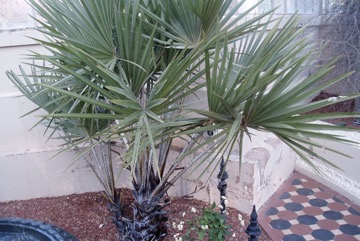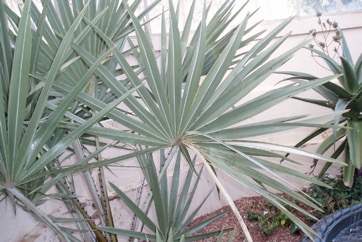Gingerbread palm, Northern lala palm

A tropical plant. It grows in the coastal regions of East Africa. In Kenya it grows from sea level to 300 m altitude. It grows along stream banks and in low lying areas. It is usually in areas with a high water table. It suits temperate regions as well as the tropics. It requires well drained soil in a sunny position. It can grow on sand dunes. It suits hardiness zones 10-12. Adelaide Botanical Gardens. In Townsville Queens BG.
Also known as:
Babangy, East African Doum Palm, Fan palm, Gingerbread tree, Hala palm, Ilala palm, Lilala, Lokoko, Mkoma pasi, Mrara, Muchevo, Mulala, Mutshema, Mwaa, N'tchea, Nnala, Palem satrana, Satrana
Synonyms
- Chamaeriphes coriacea (Gaertn.) Kuntze
- Chamaeriphes shatan (Bojer ex Dammer) Kuntze
- Chamaeriphes turbinata (H. Wendl.) Kuntze
- Corypha africana Lour.
- Hyphaene baronii Becc.
- Hyphaene beccariana Furtado
- Hyphaene hildebrandtii Becc.
- Hyphaene natalensis Kuntze
- Hyphaene oblonga Becc.
- Hyphaene parvula Becc.
- Hyphaene pileata Becc.
- Hyphaene pleuropoda Becc.
- Hyphaene pyrifera Becc.
- Hyphaene pyrifera var. arenicola Becc.
- Hyphaene pyrifera var. margaritensis Becc.
- Hyphaene shatan Bojer ex Dammer
- Hyphaene schatan var. hildebrandtii Boj.
- Hyphaene spaerulifera Becc.
- Hyphaene spaerulifera var. gosciaensis Becc.
- Hyphaene tetragonoides Furtado
- Hyphaene turbinata H. Wendl.
- Hyphaene wendlandii Dammer
Edible Portion
- Fruit pulp, Palm heart, Sap, Nuts, Vegetable
Where does Gingerbread palm grow?
Found in: Africa, Asia, Australia, Botswana, East Africa, Eswatini, Ethiopia, Indonesia, Kenya, Madagascar, Malawi, Mayotte, Mozambique, SE Asia, Somalia, South Africa, Southern Africa, Swaziland, Tanzania, United States, Zimbabwe
Notes: There are about 9 or 10 Hyphaene species. (Some authorities estimate 40).
Status: There are about 14 million palms in the Natal area. A significant fruit tree in Mozambique.
Growing Gingerbread palm, Northern lala palm
Cultivation: Plants are grown from seeds. The fleshy layer is removed. Seeds are slow to germinate and breaking the hard seed coat helps germination.
Edible Uses: The pulp of the fruit is eaten. It is also used to make wine. The palm heart is used as a vegetable. The sap is tapped to make an alcoholic drink. This is called ilala wine or busulu wine. (The tapping method kills the tree). Caution: Alcohol is a cause of cancer. The fibrous layer around the nut is eaten. The kernel of the nut is eaten. The milk from the seed is eaten. The shoots of the germinating seed are eaten as a vegetable.
Production: A palm of average size produces 68 litres of sap. Fruit are collected during the dry season.
Nutrition Info
per 100g edible portion| Edible Part | Energy (kcal) | Protein (g) | Iron (mg) | Vitamin A (ug) | Vitamin c (mg) | Zinc (mg) | % Water |
|---|---|---|---|---|---|---|---|
| - | - | - | - | - | - |
Gingerbread palm, Northern lala palm Photos


References
Balick, M.J. and Beck, H.T., (Ed.), 1990, Useful palms of the World. A Synoptic Bibliography. Colombia p 542 p 414, 449, (As Hyphaene natalensis)
Blomberry, A. & Rodd, T., 1982, Palms. An informative practical guide. Angus & Robertson. p 108, 109 (Also as Hyphaene natalensis)
Brickell, C. (Ed.), 1999, The Royal Horticultural Society A-Z Encyclopedia of Garden Plants. Convent Garden Books. p 545
Bruschi, P., et al, 2014, Traditional use of plants in a rural community of Mozambique and possible links with Miombo degradation and harvesting sustainability. Journal of Ethnobiology and Ethnomedicine. 2014, 10:59
Cundall, P., (ed.), 2004, Gardening Australia: flora: the gardener's bible. ABC Books. p 722
Dale, I. R. and Greenway, P. J., 1961, Kenya Trees and Shrubs. Nairobi. p 12
Dransfield, J. & Beentje, H., 1995, The Palms of Madagascar. Royal Botanical Gardens, Kew and The International Palm Society. p 55
Etherington, K., & Imwold, D., (Eds), 2001, Botanica's Trees & Shrubs. The illustrated A-Z of over 8500 trees and shrubs. Random House, Australia. p 390
Facciola, S., 1998, Cornucopia 2: a Source Book of Edible Plants. Kampong Publications, p 29 (Also as Hyphaene natalensis)
FAO, 1988, Traditional Food Plants, FAO Food and Nutrition Paper 42. FAO Rome p 333
Fox, F. W. & Young, M. E. N., 1982, Food from the Veld. Delta Books. p 100 (As Hyphaene natalensis)
Fruct. sem. pl. 1:28, t. 10, fig. 2. 1788
Grubben, G. J. H. and Denton, O. A. (eds), 2004, Plant Resources of Tropical Africa 2. Vegetables. PROTA, Wageningen, Netherlands. p 562
INFOODS:FAO/INFOODS Databases
Jardin, C., 1970, List of Foods Used In Africa, FAO Nutrition Information Document Series No 2.p 142 and p 34, 82 (As Hyphaene schatan var. hildebrandtii)
Johnson, D.V., 1998, Tropical palms. Non-wood Forest products 10. FAO Rome. p 116, 132
Jones, D.L., 1994, Palms throughout the World. Smithtonian Institution, Washington. p 52, 228
Jones, D.L., 2000, Palms of Australia 3rd edition. Reed/New Holland. p 164
Long, C., 2005, Swaziland's Flora - siSwati names and Uses http://www.sntc.org.sz/flora/
Magwede, K., van Wyk, B.-E., & van Wyk, A. E., 2019, An inventory of Vhavenḓa useful plants. South African Journal of Botany 122 (2019) 57–89
Maundu, P. et al, 1999, Traditional Food Plants of Kenya. National Museum of Kenya. 288p
Palgrave, K.C., 1996, Trees of Southern Africa. Struik Publishers. p 68 (As Hyphaene natalensis)
Palmer, E and Pitman, N., 1972, Trees of Southern Africa. Vol. 1. A.A. Balkema, Cape Town p 351 (As Hyphaene natalensis)
Peters, C. R., O'Brien, E. M., and Drummond, R.B., 1992, Edible Wild plants of Sub-saharan Africa. Kew. p 38
Reitveld, S., 2013, The Animals and Plants of the Zazamalala Forest in Western Madagascar. p 48
Riffle, R.L. & Craft, P., 2003, An Encyclopedia of Cultivated Palms. Timber Press. p 354
Ruffo, C. K., Birnie, A. & Tengnas, B., 2002, Edible Wild Plants of Tanzania. RELMA p 390
Ruiters-Welcome, A. K., 2019, Food plants of southern Africa. Ph.D. thesis. Univ. of Johannesburg p 29
Schatz, G.E., 2001, Generic Tree Flora of Madagascar. Royal Botanical Gardens, Kew and Missouri Botanical Garden. p 66
Schmidt, E., Lotter, M., & McCleland, W., 2007, Trees and shrubs of Mpumalanga and Kruger National Park. Jacana Media p 56
Sukarya, D. G., (Ed.) 2013, 3,500 Plant Species of the Botanic Gardens of Indonesia. LIPI p 782
Swaziland's Flora Database http://www.sntc.org.sz/flora
van Wyk, B, van Wyk, P, and van Wyk B., 2000, Photographic guide to Trees of Southern Africa. Briza. p 179
van Wyk, B., 2005, Food Plants of the World. An illustrated guide. Timber press. p 213
van Wyk, Be., & Gericke, N., 2007, People's plants. A Guide to Useful Plants of Southern Africa. Briza. p 106
van Wyk, B-E., 2011, The potential of South African plants in the development of new food and beverage products. South African Journal of Botany 77 (2011) 857–868
Van Wick, B. & Van Wick, P., 2009, Filed Guide to Trees of Southern Africa, Struik Nature. p 50
Walsh, M., 2009, The Use of Wild and Cultivated Plants as famine Foods on Pemba Island, Zanzibar. Études océan Indien. 42-43
Wickens, G.E., 1995, Edible Nuts. FAO Non-wood forest products. FAO, Rome. p166
Williamson, J., 2005, Useful Plants of Malawi. 3rd. Edition. Mdadzi Book Trust. p 137
World Checklist of Useful Plant Species 2020. Royal Botanic Gardens, Kew
www.zimbabweflora.co.zw 2011